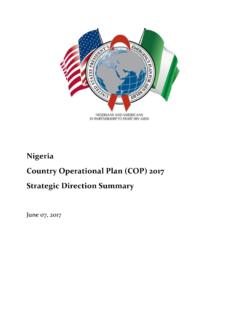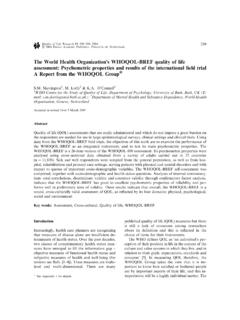Transcription of PRIMARY CARE SYSTEMS PROFILES & PERFORMANCE …
1 2500 population1 physician per625 population1 nurse perOverviewNigeria is one of the largest countries in Africa, with a population of 177 million people occupying an area of 923,678 square kilometres; just over half of Nigerians live in rural areas. PRIMARY health Care (PHC) is the foundation of the nigeria National health System. The 2013 National Demographic health Survey (NDHS)1 shows that common preventable diseases such as malaria, diarrhoea and malnutrition are major causes of morbidity and mortality in children; maternal mortality is 576/100,000; and the under-five mortality rate is 69/1000 live births.
2 Antenatal care attendance and delivery by skilled health providers are 61% and 38% respectively; and only about a quarter of children are fully vaccinated. Nigerians have an average life expectancy of a gross domestic product (GDP) per capita of US$1091 and income inequality expressed as a Gini coefficient of , nigeria is still ranked among the poorest countries in the world, with about 70% of the population living below US$1 per day. Economic indicators show that as of 2013, total health expenditure as a proportion of GDP was , and out-of-pocket payments represent over two thirds of health expenditure.
3 The World health Organization (WHO) Global health Observatory reports a physician per 1000 population of and nurse per 1000 population of , with gross inequity in rural urban distribution in terms of both number and skill a programme of health sector reform, several significant new policy initiatives in the health sector were developed, including: A revised National health Policy; a framework for achieving the health -related MDGs in the country; revitalization of the National Council on health ; launch of a National health Insurance Scheme; and the signing of the National health Act.
4 Several sub-sectoral policies/strategies/plans on public private partnership, human resources for health , health care financing, research for health , drug policy, maternal and child health , malaria control and health sector response to HIV/AIDS have been developed and National health Policy emphasises that equity in health care and health for all Nigerians is a goal to be pursued just as it affirms that health and access to quality and affordable health care is a human right. PRIMARY health care is a basic level of health care that is directed at the promotion of health , early diagnosis of disease or disability and prevention of diseases.
5 It is an essential health care made available to people in the community, within the available resources and this can only be possible through the interconnected efforts of the different functional elements of the PRIMARY care National Population Commission, 2013. nigeria Demographic and health Survey: Case StudyPRIMARY CARE SYSTEMS PROFILES & PERFORMANCE (PRIMASYS)Table 1 Key demographic, macroeconomic and health indicators of the countryResultsSourceTotal population of country 177,155,754 2014 estimateaSex ratio: male/femaleTotal population.
6 2014 estimatea Population growth annual rate 2014 estimatea Population density (people/sq km)442 people per square kilometreNDHS 2013 Distribution of population (rural/urban) (rural/urban)2014 estimatea GDP per capita (US$)1091 World Bank estimateIncome or wealth inequality (Gini coefficient) 2014 estimatea Life expectancy at years 2014 estimateaTop 5 main causes of death (ICD 10 classification)Vaccine-preventable diseases, malaria, diarrhoea, acute respiratory infections and 2013bTotal health expenditure as proportion of 2013cPublic expenditure on health as proportion of total expenditure on expenditure on health as proportion of total expenditure on payments as proportion of total health health insurance as proportion of total expenditure on health76%World health Statistics (2005 2011)
7 For 2013 estimateProportion of households experiencing catastrophic health At a non-food expenditure threshold of 40%d Number of physicians per 1000 profile- nigeria data portal Oct 26, 2015fNumber of nurses per 1000 profile- nigeria data portal Oct 26, 2015fNumber of community health workers per 1000 CIA World Fact Book ( ).b African health workforce observatory. Nigerian Human resource for health country WHO Global health Observatory ( ).d See: Onoka et al., WHO. Global health expenditure database ( ).f See: Case StudyGovernance and health service architectureNigeria operates a federal system of government comprising 36 States and the Federal Capital Territory.
8 The health system is based on a three tier structure of government ( Federal, State and Local Government Area (LGA)) each with substantial autonomy. Each State and LGA has a Ministry of health (SMOH) and Local Government health Department respectively. However, the roles and responsibilities of the different levels of the health system, with respect to PHC, remain unclear. Overlaps in roles often result in duplication of effort, wastage, or total Federal Ministry of health (FMoH) is responsible for overall stewardship and leadership for health and provision of tertiary health care, through the network of tertiary (teaching and specialist) hospitals.
9 But several states manage and finance tertiary health care facilities within their state territories. In addition, development partners also provide resources to the FMoH through the Federal Ministry of Finance (FMoF). State Ministries of health (SMoH) provide health care services through secondary level health facilities, as well as technical assistance to the LGA health Departments. LGAs own and fund PHC facilities and have overall responsibility for this level of care with the health posts and clinics, health centres and comprehensive health centres providing basic PRIMARY care services.
10 In addition to the efforts of the LGAs, PHC services have been jointly managed by SMoH, Ministries of Local Government Affairs (SMoLG), Local Government Service Commission (LGSC), Civil Service Commission (CSC), Ministry of Budget and Planning (MoBP), State Hospitals Management Board (SHMB), faith-based organizations (FBOs), nongovernmental organizations, Zonal and State offices of the National PRIMARY health Care Development Agency (NPHCDA), FMoH, National health Insurance Scheme (NHIS), Development Partners, among others.
















